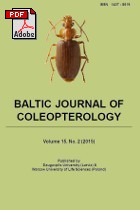Parameters of ecological niches ofBadister,Licinus andPanagaeus (Coleoptera, Carabidae) species measured against eight ecological factors
Main Article Content
Keywords
:
ecological niche; litter; moisture; soil salinity; tree crown density; herbaceous layer cover
Abstract
Based on the results of research conducted between 2001 and 2014 in five administrative regions in the south of Ukraine the abundance of 6 ground beetle species has been analysed in relation to 8 ecological factors. This analysis showed that the abundance of Badister bullatus (Schrank, 1798) reached its maximum in forests with a sparse herbaceous layer, thick litter, loamy and clay soil. B. lacertosus Sturm, 1815 is most abundant in areas with low soil salinity, on loamy soils. The abundance of B. unipustulatus Bonelli, 1813 reaches its maximum in hygrophilous moisture conditions. The abundance of Licinus depressus (Paykull, 1790) in forests of the steppe zone decreases on saline soils in conditions of increased insolation, in coniferous forests, in areas with no litter, on sandy soils and near ant-hills. The abundance of Panagaeus bipustulatus (Fabricius, 1775) reaches its maximum in forests with average tree crown density, with sparse grass cover, average litter thickness, with xeromesophilous and mesophilous moisture, on loamy soils with average salinity and low to average numbers of ants. The abundance of P. cruxmajor (Linnaeus, 1758) increases in areas of high tree crown density, on sandy soils with average salinity, low and average numbers of ants.
Article Details
Statistics
Downloads
Download data is not yet available.
Recommend Articles
